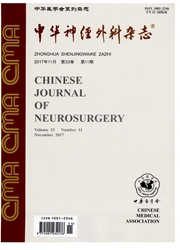

 中文摘要:
中文摘要:
目的观察神经干细胞(NSC)、许旺细胞(SCs)和组织工程材料乙交酯-丙交酯共聚物(PLGA)大鼠髓内共移植后的病理形态学改变。方法36只Wistar大鼠,随机分为PLGA移植组、NSC/PLGA组和NSC+SCs/PLGA组。体外培养、鉴定胚胎脊髓源NSC和SCs,制备和构建PLGA支架细胞复合体并移植到大鼠脊髓T9半横断损伤部位,应用HE染色、电镜和免疫组织化学染色方法在形态结构上观察材料的组织相容性、轴突髓鞘再生及NSC在脊髓内的存活、迁移和分化情况。结果HE染色观察损伤12周时移植材料内可见细胞生长及新生的毛细血管;扫描电镜观察随着时间的延长,PLGA逐渐降解;材料正中横断面透射电镜观察可见新生的无髓及有髓神经纤维;脊髓标本免疫组织化学染色可见移植的NSC可以在宿主脊髓内存活、迁移并分化成类神经元样细胞和少枝胶质细胞,未分化成星形胶质细胞。结论NSC、SCs和PLGA共移植可以在形态学上促进大鼠脊髓半横断损伤的修复。
 英文摘要:
英文摘要:
Objective To observe the pathological change of the coransplantation of neural stem cells(NSC) , Schwann cells (SCs) and PLGA to the spinal cord injury in rats. Method Thirty-six Wistar rats were divided into three groups randomly: PLGA, NSC/PLGA and NSC + SCs/PLGA groups. The complex of PLGA-cells was constructed and implanted into the injury site of T9 SCI models developed from Wistar rats. All the SCI tissues were observed with electromicroscope, HE and immunohistochcmistry to identify the biocompatibility of PLGA, regeneration of neural fibers and the survival, migration and differentiation of the transplanted cells at 4, 8 and 12 weeks after injury. Results Different cells and regenerated blood capillary were detected in the scaffolds through HE stain. The PLGA gradually degenerated under scanning electromicroscope. The regenerated axons were observed in the scaffold-cells complex with electromicroscope. Immunohistochemistry staining showed the transplanted NSC could survive and migrate at 12 weeks and differentiated into neurons and oligodendrocytes. Conclusions Co-transplantation of NSC + SCs/PLGA can morphologically promote the reparation of the injured spinal cord.
 同期刊论文项目
同期刊论文项目
 同项目期刊论文
同项目期刊论文
 期刊信息
期刊信息
